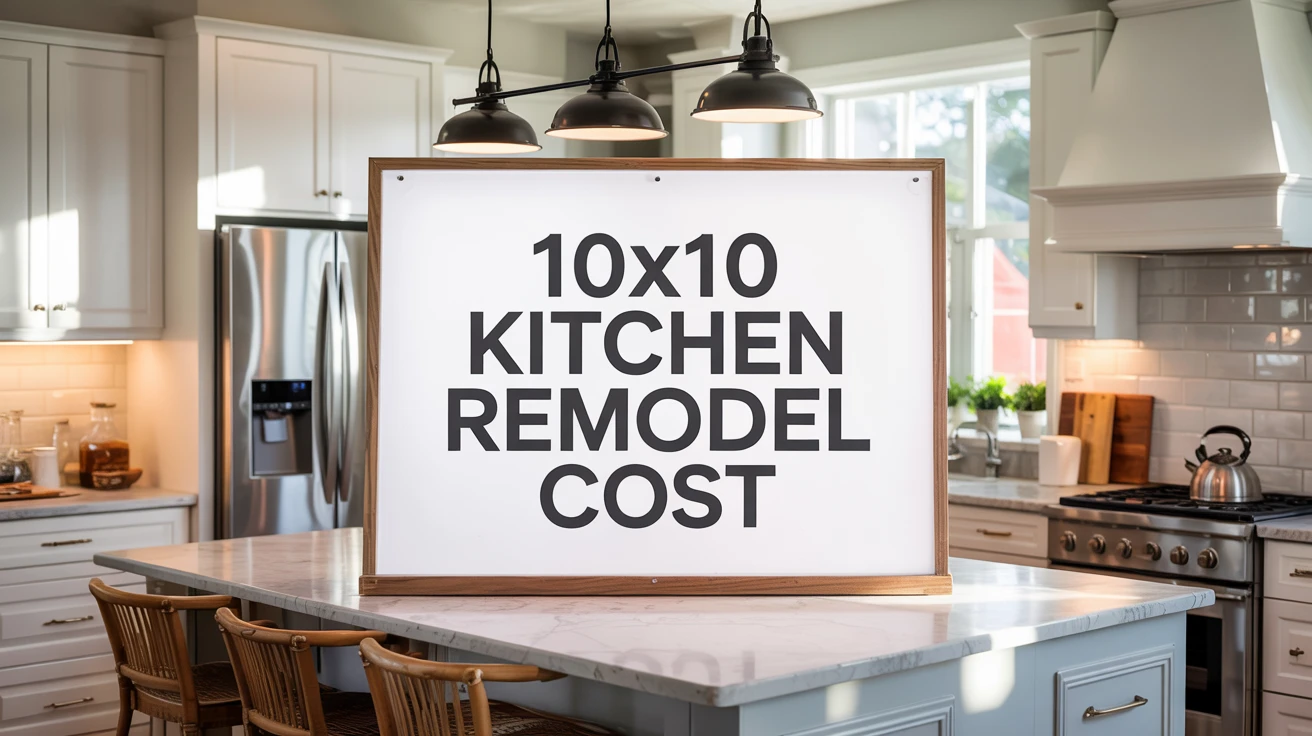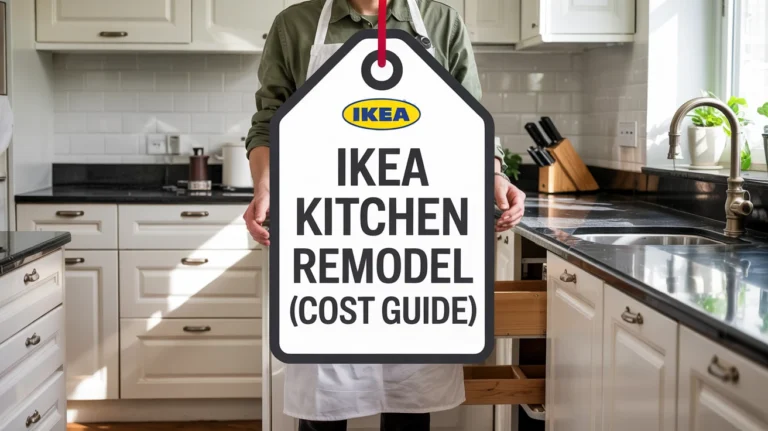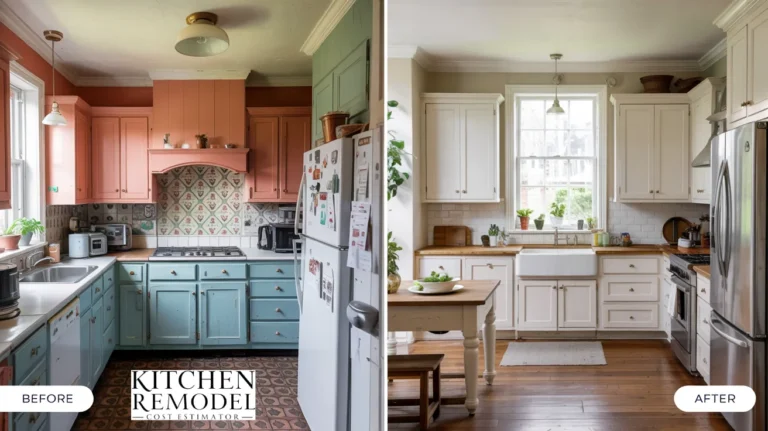A standard 10×10 kitchen renovation presents the ultimate balancing act between immediate costs and long-term value, with your cabinet selection alone consuming nearly 37% of your total budget. When homeowners ask me at trade shows which upgrades deliver actual value (versus which ones just look good on Pinterest), they’re really just asking the question that matters most…
How much should a 10×10 kitchen remodel cost, anyway?
The average cost to remodel a 10×10 kitchen ranges from $15,000 to $30,000. Costs vary based on materials, layout changes, and appliance upgrades. High-end remodels with custom cabinets and luxury finishes can exceed $45,000, while budget-friendly updates may cost under $10,000 using stock materials and minimal changes.
10×10 Kitchen Remodel Cost Estimator
10×10 Kitchen Remodel Cost Calculator
Get an estimate for your kitchen renovation based on your specifications.
Estimated Kitchen Remodel Cost
This estimate is based on national averages and may vary based on your location, material availability, contractor rates, and other factors. Prices are estimates only and should be used for planning purposes.
Looking for more accurate costs in your area? Search for location-specific remodel costs.
Typical Costs Associated with Remodeling a 10×10 Kitchen
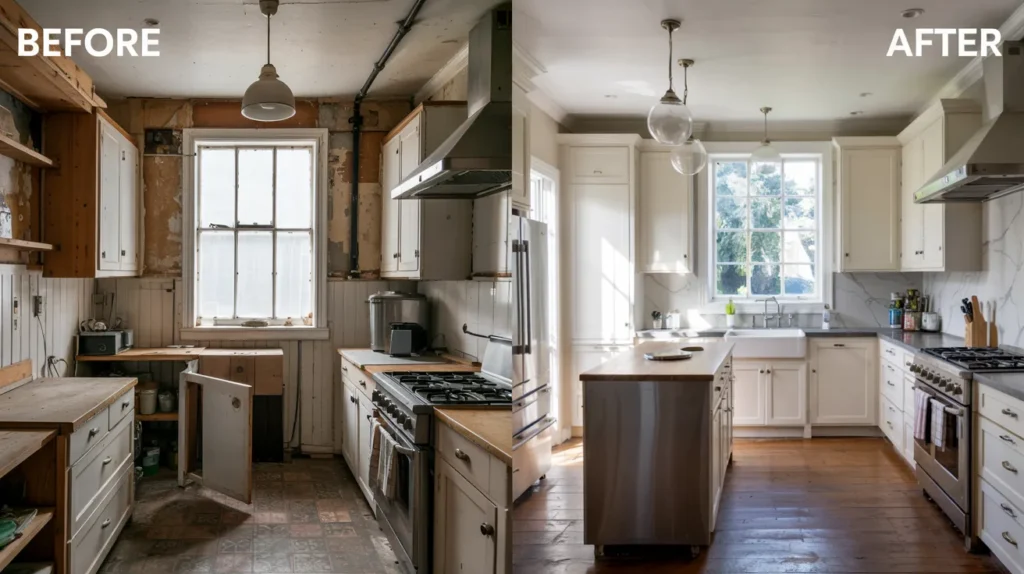
National Average Kitchen Remodel Costs
Ever wondered what that kitchen renovation might actually cost you? The 2024 Cost vs. Value Report by Remodeling Magazine has some answers that might surprise you.
This report breaks down kitchen remodels into different categories, giving you real numbers to work with rather than just vague estimates from contractors.
Let’s start with the basics. A mid-range minor kitchen remodel—think updating without changing your layout—comes in at an average of $27,492.
But here’s where it gets interesting: that same minor remodel typically returns $26,406 at resale. You’re looking at recouping 96.1% of your investment! Almost dollar-for-dollar return. That’s rare in home improvements.
What happens when you go bigger?
A mid-range major kitchen remodel—complete with new cabinets, layout changes, and updated appliances—jumps to $79,982 on average.
The resale math changes dramatically here. You’ll typically see about $39,587 back, recovering just 49.5% of what you spent. That considerable gap shows that while you’ll enjoy your fancy new kitchen, the next buyer won’t necessarily pay for all those customizations.
And for those dreaming of a magazine-worthy showpiece?
The upscale major kitchen remodel represents serious investment territory at $158,530. This gets you top-of-the-line everything—custom designs, premium materials, professional-grade appliances.
At resale, this lavish kitchen typically returns $60,176, or about 38% of your investment. The absolute dollar increase is highest here, but percentage-wise, it’s the lowest return of all three options.
National Average Kitchen Remodel Costs and ROI
| Remodel Type | Total Job Cost | Resale Value | Cost Recouped (%) |
|---|---|---|---|
| Mid-Range Minor | $27,492 | $26,406 | 96.1 |
| Mid-Range Major | $79,982 | $39,587 | 49.5 |
| Upscale Major | $158,530 | $60,176 | 38.0 |
Budget Allocation for Kitchen Remodel Components
Ever stared at your kitchen wondering where all that remodeling money actually goes? The National Kitchen & Bath Association (NKBA) has broken this down into percentages that might help you make sense of your contractor’s quote.
pie showData
title "Kitchen Remodel Budget Allocation"
"Cabinetry & Hardware" : 33
"Installation/Labor" : 16.5
"Appliances & Ventilation" : 14.5
"Countertops" : 10
"Lighting/Electrical" : 7.5
"Flooring" : 7
"Plumbing/Faucets/Sinks" : 4.5
"Walls & Ceilings" : 4
"Backsplash" : 5
"Design Fees" : 4
"Doors & Windows" : 4
"Miscellaneous" : 2.5Think cabinets aren’t a big deal? Think again.
Cabinetry and hardware typically swallow the biggest chunk of your budget—anywhere from 29% to 37%. This makes sense when you consider cabinets are both the face and the function of your kitchen. They’re what you see first and what you’ll interact with daily.
Installation and labor costs might shock you at 13% to 20% of your budget. But remember, a kitchen remodel involves plumbers, electricians, carpenters, and sometimes structural changes. That expertise comes at a price.
What about those shiny new appliances?
They’ll claim about 12% to 17% of your total. This covers everything from your refrigerator to your dishwasher, oven, microwave, and ventilation system. The range here depends largely on whether you’re going with basic models or smart appliances with all the bells and whistles.
Countertops take a smaller but still significant 9% to 11% slice of the pie. The material you choose here—from budget-friendly laminate to luxury natural stone—can swing this percentage considerably.
Flooring accounts for 5% to 9% of your budget. It’s literally the foundation of your kitchen, yet many homeowners underestimate its importance and cost.
The remaining portions get distributed across lighting and electrical work (5% to 10%), plumbing fixtures (3% to 6%), and walls and ceilings including paint (3% to 5%).
Don’t forget about design fees (around 4%) if you’re hiring a professional designer. Doors and windows might take another 4% if they need replacing.
That beautiful backsplash you’ve been dreaming about? Budget about 5% for it.
And here’s a tip from seasoned renovators: always set aside 5% to 25% as contingency. Because when you start opening up walls, surprises happen—and they’re rarely the money-saving kind.
NKBA Recommended Kitchen Remodel Budget Allocation Percentages
| Budget Component | Recommended Percentage Range |
|---|---|
| Cabinetry and Hardware | 29% – 37% |
| Installation/Labor | 13% – 20% |
| Appliances and Ventilation | 12% – 17% |
| Countertops | 9% – 11% |
| Flooring | 5% – 9% |
| Lighting/Electrical | 5% – 10% |
| Plumbing/Faucets/Sinks | 3% – 6% |
| Walls and Ceilings | 3% – 5% |
| Design Fees | 4% |
| Doors and Windows | 4% |
| Backsplash | 5% |
| Miscellaneous | 1% – 4% |
| Contingency | 5% – 25% |
Detailed Cost Breakdown by Component
Cabinetry
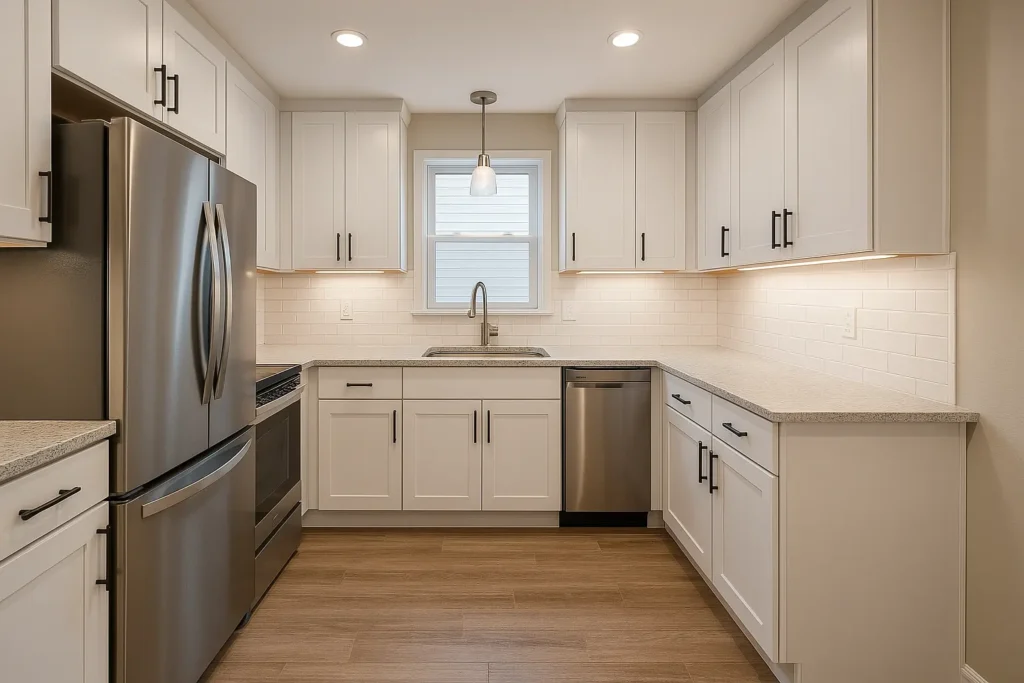
How much difference does cabinet quality really make to your bottom line? As it turns out, quite a lot.
Stock cabinets—those pre-made options available in standard sizes—will run you between $60 and $400 per linear foot installed. The lower end gets you basic materials and simple designs, while the upper range represents better quality stock options or more complex installations.
Want something a bit more tailored to your space?
Semi-custom cabinets offer more flexibility in size, style, and finish. Expect to pay between $100 and $900 per linear foot installed. That wide range reflects the various levels of customization and material quality you can choose from.
For the “exactly how I want it” approach, custom cabinets provide complete design freedom. You specify every dimension, material, and finish detail.
The price? Anywhere from $100 to $1,500+ per linear foot installed. Yes, that’s a huge range, but that’s because your choices are virtually unlimited—from exotic woods to specialized finishes and complex designs.
Countertops
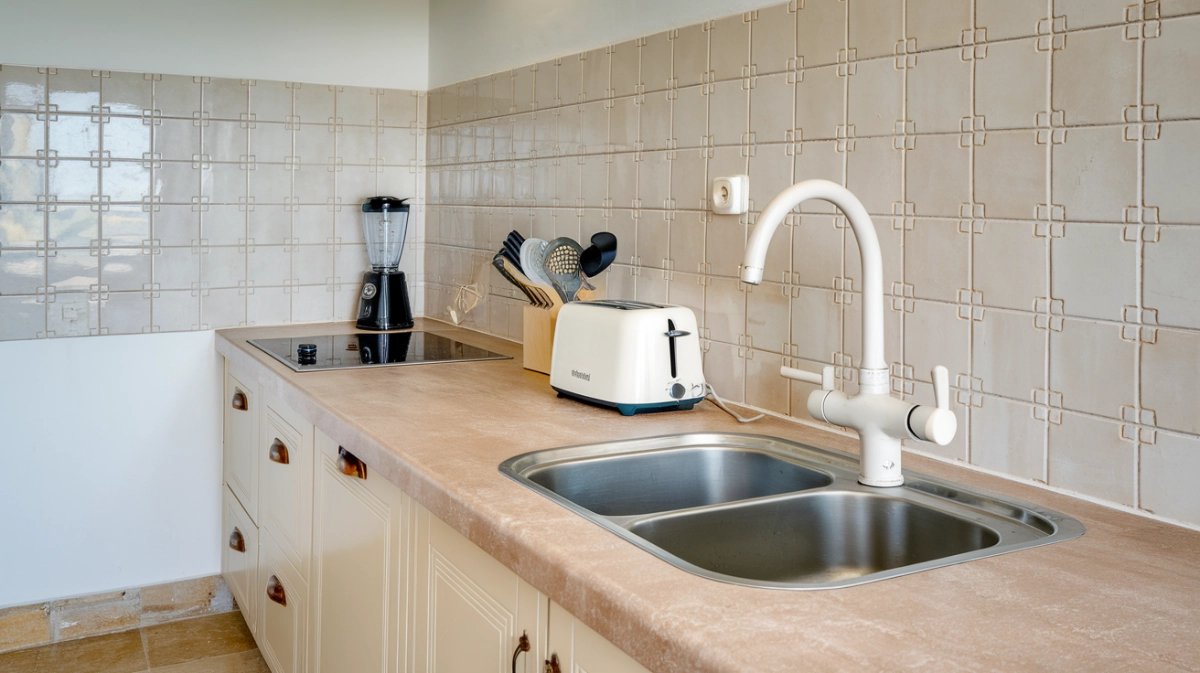
The surface you prep, cook, and gather around comes in more options than you might think.
Laminate countertops remain the budget-friendly champion at $10 to $80 per square foot installed. The variation depends on the grade, finish, pattern, and any fancy edge treatments you might select.
Granite, with its natural durability and one-of-a-kind patterns, ranges from $30 to $250 per square foot installed. What causes such a wide range? The quality and rarity of the specific granite slab, plus how complicated your installation might be.
Quartz countertops—engineered from quartz particles and resin—have become increasingly popular for their durability and low maintenance. Expect to pay $40 to $200+ per square foot installed, depending on brand, color, pattern, and finish.
Solid surface countertops (think Corian and similar brands) provide that seamless look. They’ll cost you between $10 and $150 per square foot installed, with price varying based on brand, color, pattern, and edge treatments.
Appliances (Standard Package: Refrigerator, Oven/Range, Microwave, Dishwasher)
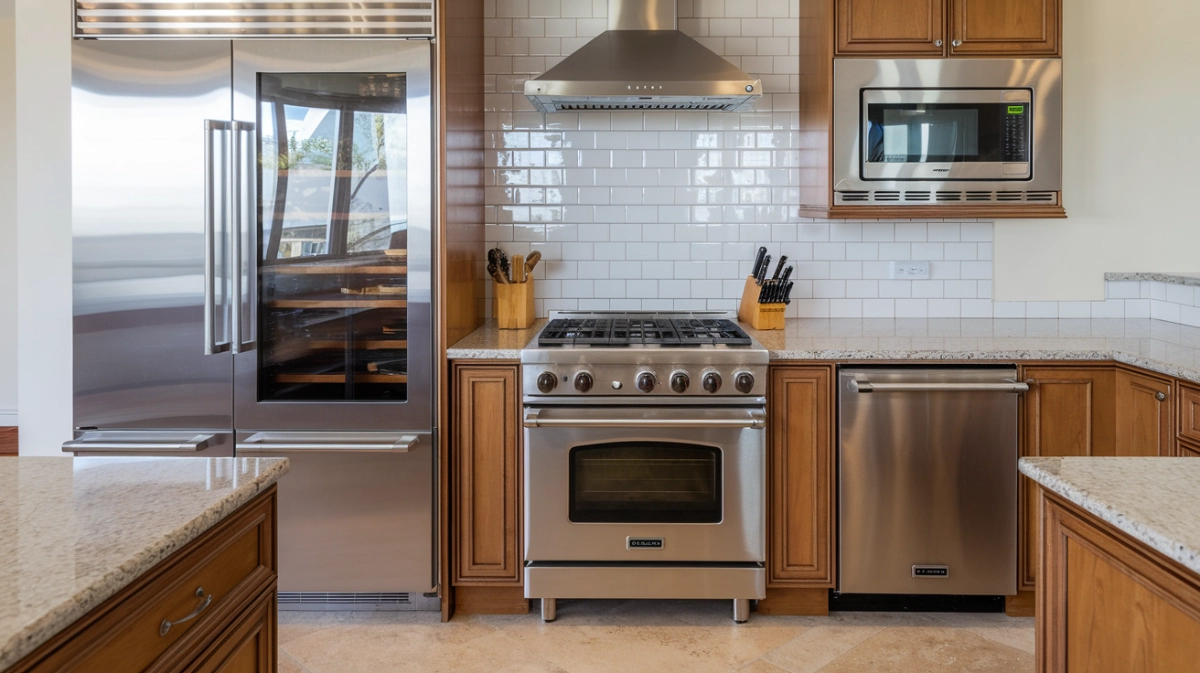
How much should you budget for that complete appliance package?
A standard kitchen suite (refrigerator, oven/range, microwave, and dishwasher) runs between $1,197 and $9,074—or even more for ultra-premium brands.
What drives this enormous price range? Brand reputation, features, finish (that fingerprint-resistant stainless steel costs more), and energy efficiency ratings all play a role in the final price tag.
Flooring
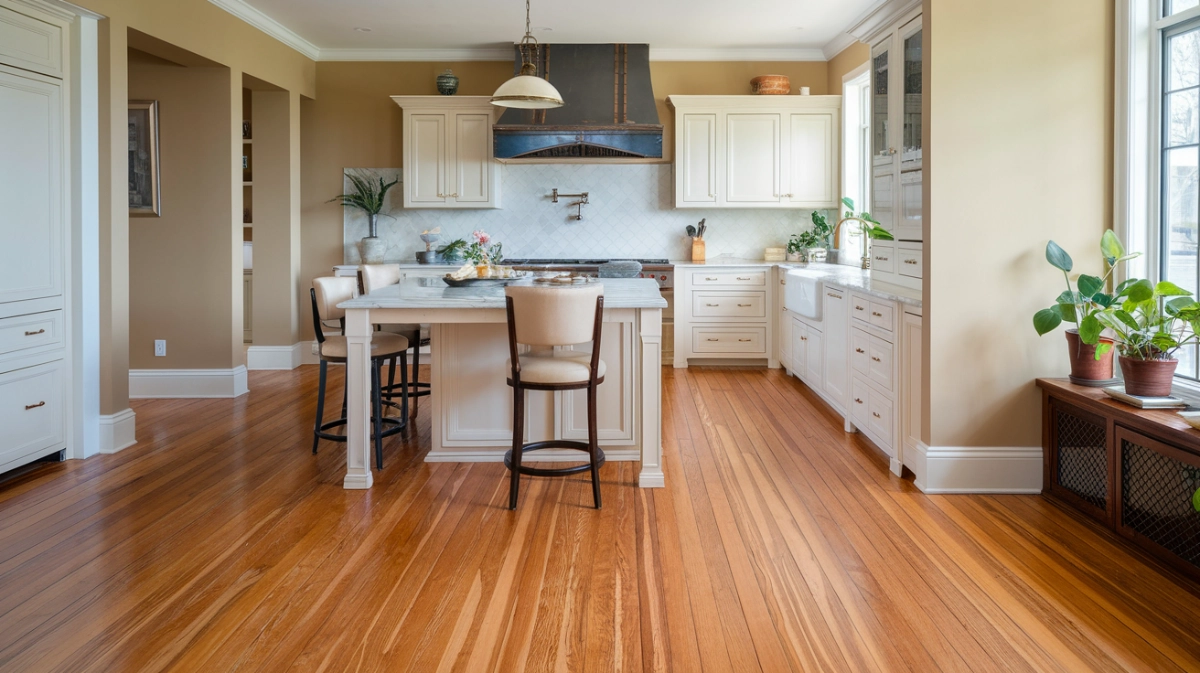
The surface you stand on while cooking matters more than you might think, both for comfort and durability.
Tile flooring, including ceramic and porcelain options, ranges from $2 to $50 per square foot installed. Ceramic tiles generally cost less, while porcelain offers better durability at a higher price. Your final cost depends on the specific type, size, pattern, and installation complexity.
Hardwood flooring brings timeless appeal to your kitchen at $3 to $45 per square foot installed. The species of wood makes a huge difference here—oak will cost much less than exotic options like Brazilian cherry. Also factoring in: whether you choose solid or engineered hardwood, and the finish quality.
Looking for something more budget-friendly with wood appeal?
Laminate flooring costs between $3 and $14 per square foot installed. The price varies with thickness, wear layer quality, and style sophistication (some high-end laminates convincingly mimic wood or stone).
Vinyl flooring has come a long way from your grandmother’s kitchen. Modern vinyl offers excellent water resistance and durability at $2 to $16+ per square foot installed. Options include sheet vinyl, vinyl tiles, and luxury vinyl planks (LVP), with LVP commanding premium prices for its enhanced durability and realistic appearance.
Labor
Ever wonder why labor costs seem all over the map? They can represent anywhere from 13% to 67% of your total project cost!
This huge range depends on the extent of your remodel, work complexity, and how much DIY you’re willing to tackle. Complete kitchen gutting with layout changes will obviously require more professional hours than a simple cabinet refresh.
Different trades also come with different price tags:
- Plumbers: $45 to $200 per hour
- Electricians: $50 to $100 per hour
- Carpenters: $40 to $70 per hour
- Handyman services: $50 to $125 per hour
These varying rates reflect the specialized skills and licensing requirements of each profession—and explain why that small plumbing fix might come with a surprisingly large bill.
Return on Investment (ROI)
“Will I get my money back?” It’s the question every homeowner asks before plunging into a kitchen renovation. The answer? It depends.
The return on investment for a mid-range kitchen remodel can vary dramatically—from 31.7% to 96.1%. What causes such a wide spread?
Several factors come into play: the scope of your remodel (minor versus major), quality of materials, and perhaps most importantly, your local real estate market conditions. If your neighborhood has a ceiling on home values, even the most gorgeous kitchen might not boost your selling price proportionally.
Generally speaking, minor, less extensive remodels tend to yield a higher percentage of cost recouped. This makes sense when you think about it—you’re addressing the kitchen’s pain points without overbuilding for the neighborhood.
What about those dream kitchens with all the luxury touches?
Upscale kitchen remodels typically show a lower return on investment, with percentages ranging from 22.7% to 53.5%. The premium materials, custom designs, and high-end appliances often don’t translate dollar-for-dollar into resale value.
That doesn’t mean they’re not worth doing—just that your motivation should include personal enjoyment, not just financial return. While an upscale remodel might appeal to a specific segment of buyers, the broader market may not value your commercial-grade range or custom cabinetry as much as you do.
This doesn’t mean you should skip the renovation if you’re planning to stay in your home for years. The daily enjoyment of a well-designed kitchen might be worth the investment regardless of the financial return.
Kitchen Remodel Return on Investment (ROI)
| Remodel Type | ROI Percentage Range |
|---|---|
| Mid-Range | 31.7% – 96.1% |
| Upscale | 22.7% – 53.5% |
Kitchen Insulation
Did you know your kitchen remodel is the perfect opportunity to improve your home’s energy efficiency? Most people focus on the visible elements, but what’s inside your walls matters too.
The recommended R-value for kitchen walls typically falls between R-13 and R-23. What’s an R-value? It’s basically a measure of how well your insulation resists heat flow—and higher numbers mean better insulation.
The specific R-value you need depends on where you live. Those IRC climate zones aren’t just bureaucratic jargon—they actually matter for your comfort and energy bills. Living in Phoenix? You might get away with lower R-values. Minneapolis? You’ll want to max out that insulation.
Standard 2×4 walls typically use R-13 or R-15 insulation, while 2×6 walls can accommodate the beefier R-19 or R-21 options.
What about the ceiling? Since heat rises, your kitchen ceiling actually needs more insulation than the walls.
Recommended R-values for kitchen ceilings range from R-30 to R-60. This higher range helps prevent heat loss during winter and reduces heat gain in summer, directly affecting both your comfort and your utility bills.
Again, your climate zone dictates exactly how much insulation you need—colder climates require higher R-values for optimal energy efficiency.
Before starting your project, check your local building codes. Insulation requirements vary by location, and you’ll want to ensure compliance.
Different insulation materials—fiberglass, cellulose, spray foam—offer varying R-values per inch of thickness. This is worth considering when selecting insulation for your kitchen remodel, especially if space within wall cavities is limited.
Conclusion
What’s the bottom line for your 10×10 kitchen?
The numbers tell the story: $27,492 for a basic refresh or up to $158,530 if you’re going all-in on luxury. But here’s the kicker—minor updates recoup nearly 96% at resale, while those showpiece kitchens return just 38%.
Your biggest expense? Likely cabinets, commanding up to 37% of your budget.
The sweet spot for most homeowners lies somewhere between bare-minimum updates and dream kitchen territory. Focus on what matters daily: quality cabinets that won’t fall apart, countertops that can handle real cooking, and appliances that work reliably.
Don’t skip the invisible improvements. Those R-values inside your walls might not impress guests, but they’ll keep your space comfortable and your energy bills reasonable.
The best kitchen remodel isn’t the most expensive—it’s the one that fits how you actually live and cook.

